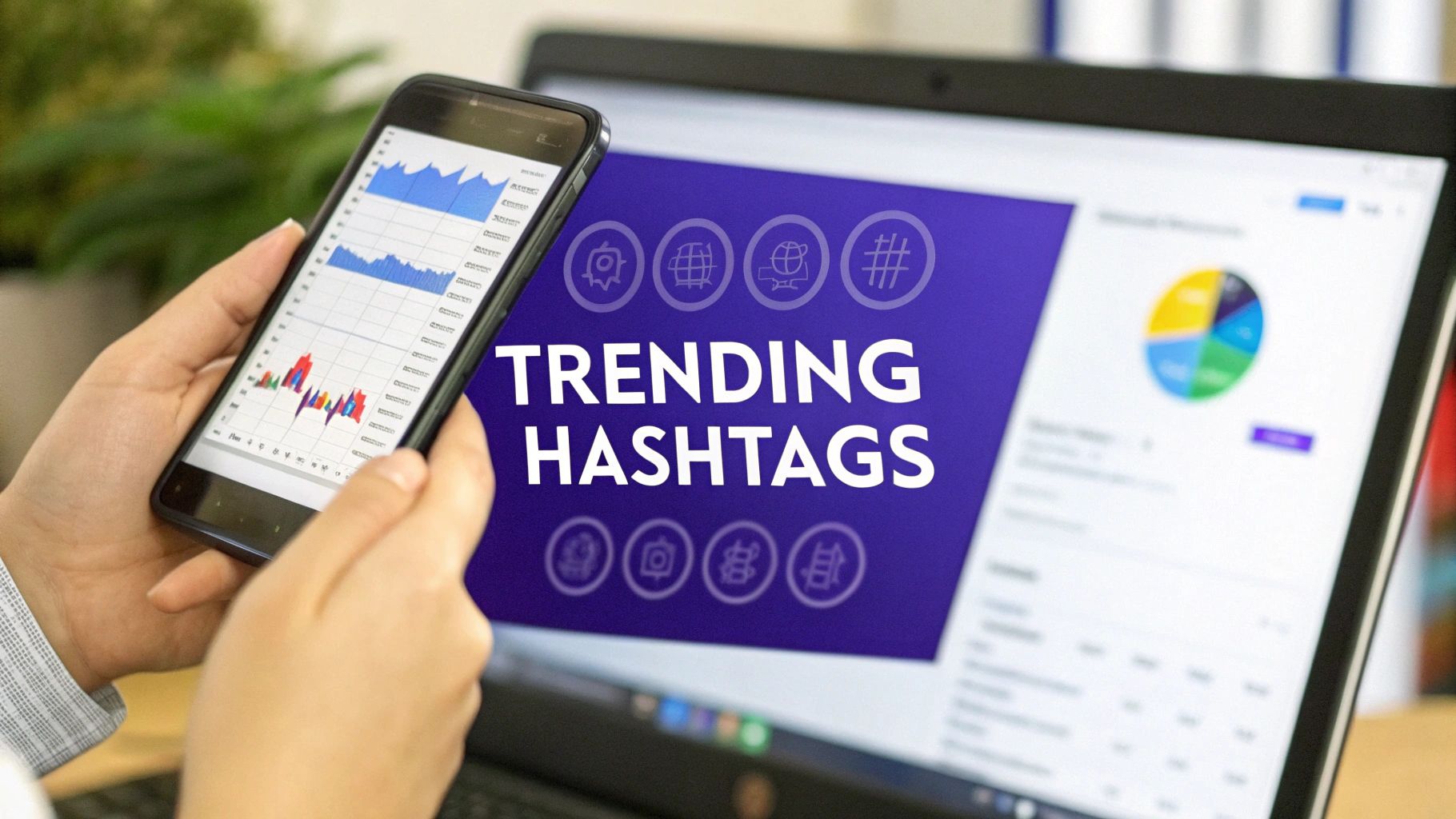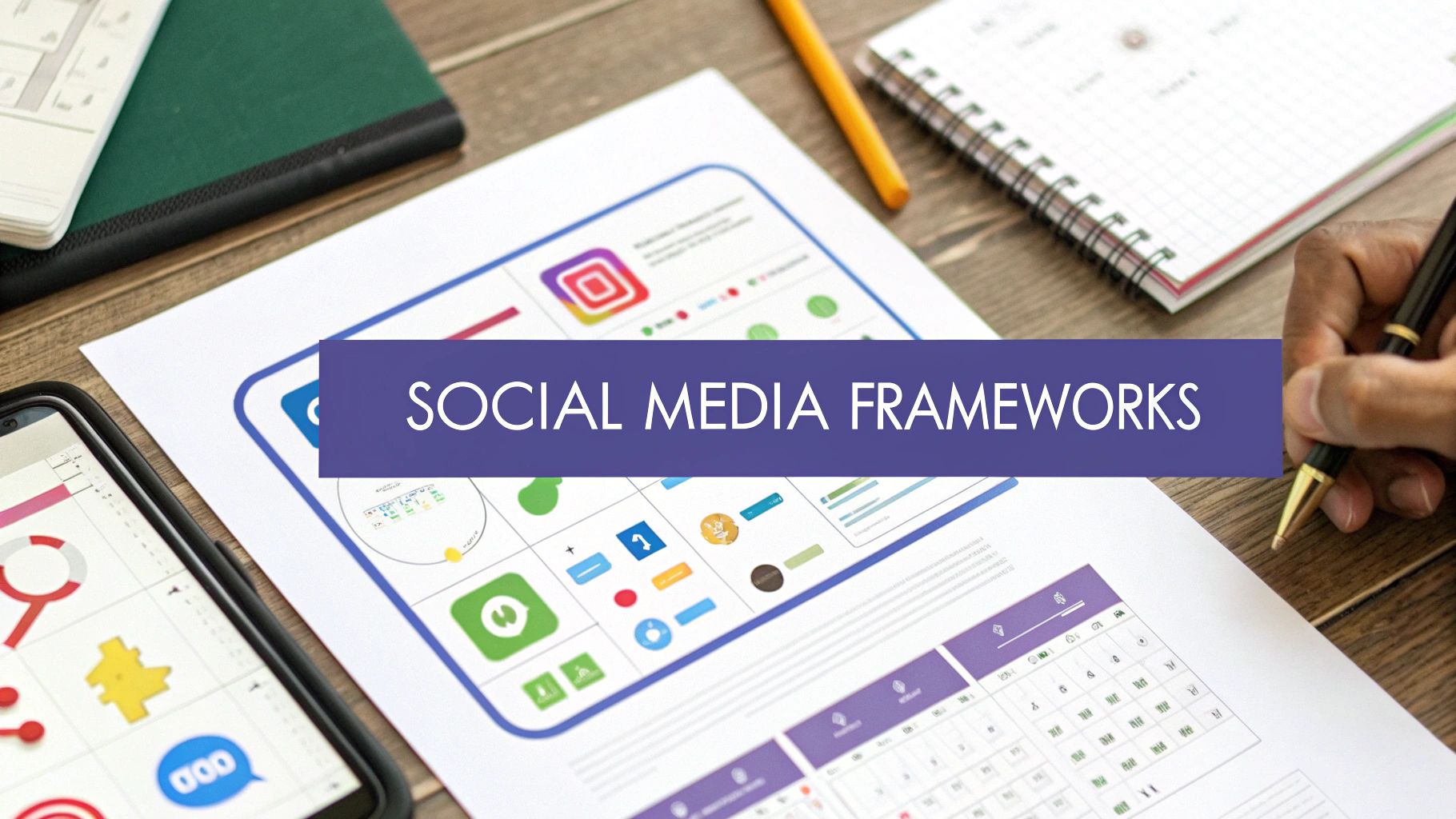So, you want to find the right trending hashtags. You can either spend time digging through social media feeds yourself on platforms like X and Instagram, or you can use a specialized tool like PostSyncer to get straight to the data-driven insights.
Honestly, the best approach is a mix of both. Use the platforms to get a feel for the real-time vibe, then lean on the tools to see what’s actually performing.
The Real Power of Trending Hashtags Today
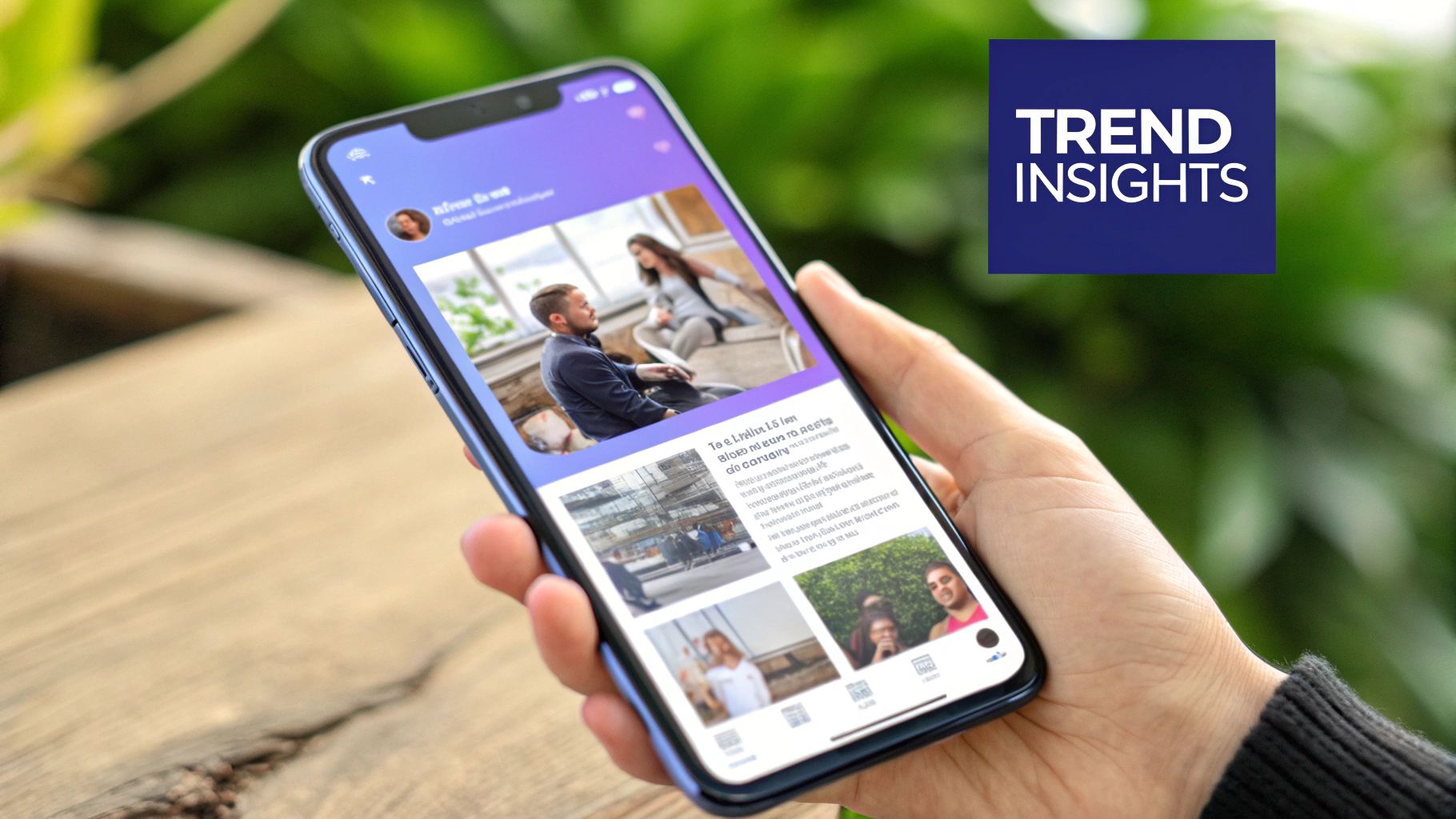
Let's clear the air right away—hashtags are far from a social media relic. I've seen firsthand how they've evolved. Instead of just being decorative fluff at the end of a post, they are now powerful discovery funnels. They actively connect your content with conversations and audiences who don’t even follow you yet.
Think of them as signposts. They guide users who are already interested in your niche directly to your brand. Understanding how to find and use them is a learnable skill, not just guesswork. It's about having a clear, repeatable strategy.
Why Your Hashtag Strategy Matters
There's a persistent myth that hashtags are dead. As someone who analyzes social media performance daily, I can tell you the data tells a completely different story. Posts that strategically use hashtags see 13.8% higher engagement on average compared to posts without them. That's not a small number.
Even more impressive? Content that taps into trending hashtags can reach up to 42% more users outside your follower base. You can dig into more of this kind of data over at Recurpost.
This proves that a well-researched hashtag strategy isn't just a nice-to-have; it's a non-negotiable part of modern social media marketing. It's the difference between shouting into an empty room and joining a relevant, bustling conversation.
Key Takeaway: Hashtags are not just for reach; they are for relevant reach. They connect you with users who are actively searching for or engaging with topics related to your brand, leading to higher-quality interactions.
To help you get started, here's a quick rundown of the main ways people find effective hashtags.
Core Approaches to Finding Trending Hashtags
| Method | Best For | Key Benefit |
|---|---|---|
| Manual Platform Search | Capturing real-time cultural moments and unfiltered trends. | Gives you an authentic feel for what's currently buzzing on platforms like X or Instagram. |
| Competitor Analysis | Understanding what works for established players in your niche. | Provides a proven starting point and helps you find relevant community tags. |
| Specialized Hashtag Tools | Getting data-driven performance metrics and efficiency. | Saves a massive amount of time and gives you hard data on reach and engagement potential. |
Each method has its place. The real magic happens when you combine the human insight from manual searching with the efficiency and data from a good tool.
The Core Types of Hashtags
To build a solid strategy, you need to work with a mix of different hashtag types. I've seen the most success when brands blend them together. Each one serves a unique purpose:
Community Hashtags: These are the tags that connect users around a shared interest or identity. Think
#BookLoversfor a bookstore or#HomeCooksfor a food blogger. They create a sense of belonging and pull in a highly relevant audience.Campaign Hashtags: You'll create these for a specific marketing initiative, like a product launch or a contest (e.g.,
#PostSyncerLaunch2025). They are usually temporary but are fantastic for tracking entries and measuring the buzz around a specific event.Trending Hashtags: These are the fast-moving tags tied to current events, memes, or viral challenges. Using them correctly can give you a massive, though often short-lived, boost in visibility. It's about jumping into a conversation that's already happening.
A winning approach almost always involves a mix of all three. This ensures your content has both long-term relevance from community tags and immediate discovery potential from trending ones.
Before you even think about pulling out your wallet for a fancy tool, the best place to start looking for trending hashtags is right where the action happens. The major social platforms are absolute goldmines of real-time data, but only if you know where to look and how to read the signs.
This hands-on approach is more than just a free alternative; it's how you build a real gut feeling for what's capturing people's attention organically. It helps you understand the why behind a trend, not just the what. That's something automated tools, for all their power, often miss—the cultural pulse that makes a trend truly take off.
Finding Trends on X and Instagram
On X (what we all used to call Twitter), your first stop should always be the "Explore" tab. It’s literally built to show you what topics and hashtags are blowing up right now. For local businesses, this is huge. The ability to filter trends by specific locations lets you tap into conversations happening right in your backyard.
Here's what the "Explore" page looks like, serving up tailored trends on a silver platter.
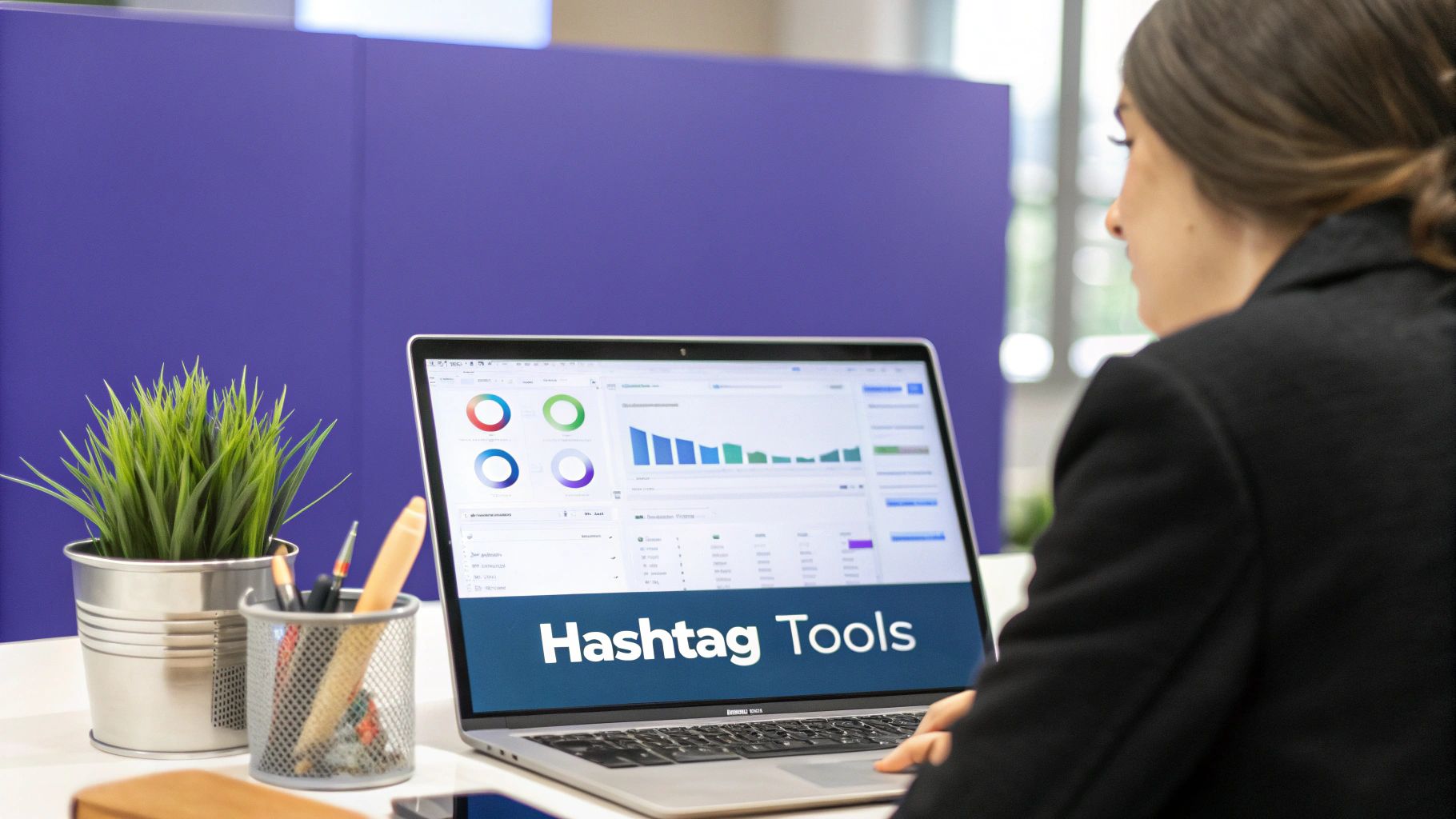
This view instantly gives you a list of hashtags and topics driving the conversation, offering a direct line to what people are actively talking about.
Instagram, on the other hand, requires a bit more detective work. Don't just do a basic hashtag search and call it a day. Dive into the "Top" posts for a relevant tag. What do you see? Pay close attention to the secondary hashtags that high-performing accounts are using over and over. Also, keep an eye on the influencers in your niche to see which tags they consistently lean on to get great engagement—not just the massive, generic ones.
A classic rookie mistake is only focusing on giant hashtags like
#marketing. The real gems are often the niche tags like#B2BContentStrategythat consistently pop up alongside the big ones in successful posts. That's your clue on how to reach a much more focused audience.
Tapping into TikTok's Trend Ecosystem
TikTok is a whole different ballgame. Trends here are often born from sounds, challenges, and specific video styles more than simple keywords. Your "For You Page" (FYP) isn't just for entertainment; it's your most powerful research tool.
Understanding TikTok's unique trending mechanisms is essential, especially since what starts on TikTok often sets the tone for the rest of the internet. Notice which sounds and video formats you see again and again. When you tap the sound at the bottom of a video, you can see how many other creators have jumped on it, which is a dead giveaway of its popularity.
Using Smart Tools for Hashtag Discovery
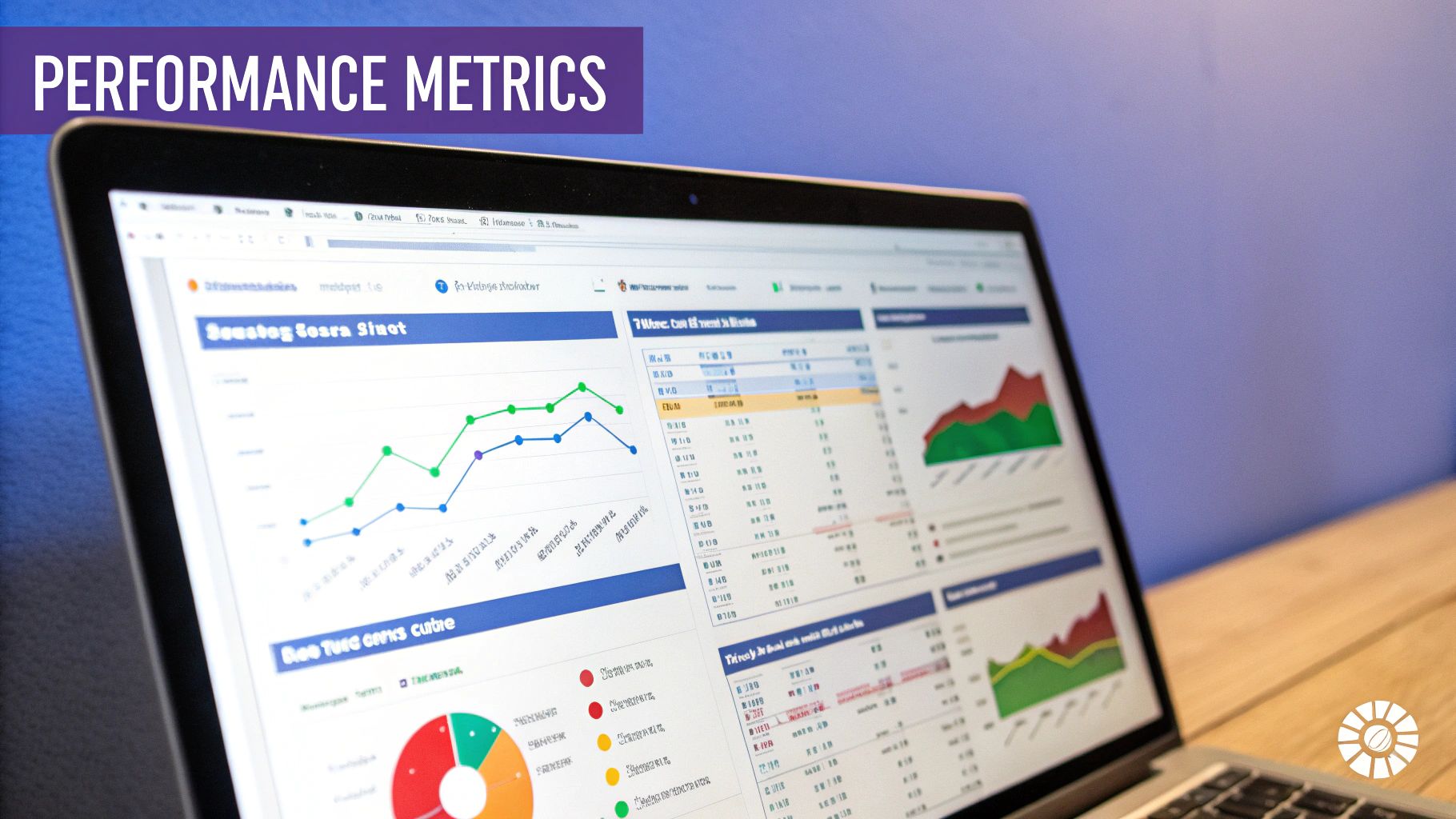
While manually digging through hashtags gives you a gut feeling for what’s resonating, it's the smart tools that really give you a competitive edge. This is where you shift from guessing what might be popular to knowing what’s actually working based on cold, hard data. Think of them as your shortcut to doing this whole process faster and more accurately.
For instance, AI-powered platforms like our own PostSyncer are designed to uncover those niche and emerging hashtags you’d probably never stumble upon yourself. Other great tools like RiteTag and Hashtagify provide real-time data on a tag’s performance, showing you its potential reach and how much competition you’re up against before you commit.
Turning Data Into a Strategy
So, how does this actually work in practice?
Let's imagine you run a small, sustainable fashion brand. You're about to launch a new line of organic cotton t-shirts, so your starting point—your "seed" keyword—is #organicfashion. That’s a decent start.
Now, instead of just scrolling through that tag, you plug it into a smart tool. It instantly analyzes your seed term and spits out a whole list of related tags, complete with the performance metrics you need. By the way, the core principles of how to conduct keyword research are a perfect fit here; you're essentially doing the same thing, just for hashtags.
The tool might give you suggestions broken down by potential impact:
- High Volume (Broad Reach):
#sustainablefashion,#ethicalfashion - Medium Volume (Niche Community):
#organiccotton,#slowfashionmovement - Low Volume (Hyper-Targeted):
#consciouscloset,#ecofriendlythreads
This right here is the magic of using the right tools. They take one simple idea and transform it into a multi-layered strategy. You get a balanced mix of hashtags that hit all the right notes: broad visibility, connection with a dedicated community, and attraction of highly qualified buyers.
From a List to an Action Plan
With this kind of data in hand, your job is no longer to guess but to strategize. You can now build different hashtag sets to test for different types of posts. For that big launch announcement, you’d likely want to pull a few tags from each of those categories to maximize your post's potential.
Contrast that with just grabbing the first ten tags you see. Instead of just adding to the noise, you’re making calculated decisions based on post volume and competition. This is how you find trending hashtags that don't just get you seen, but actually drive real, meaningful engagement for your brand. It's about working smarter, not harder.
Choosing Hashtags That Actually Drive Results
So, you've got a giant list of potential hashtags. That's a good start, but it's just raw material. The real magic happens when you move from simply finding tags to strategically choosing the ones that will do the heavy lifting for your brand.
It’s not just about getting more eyeballs on your content. It’s about getting the right eyeballs—the people who will genuinely care about what you have to say and, ultimately, become loyal followers or customers.
A classic mistake I see all the time is brands chasing only the massive, high-volume hashtags. Sure, a tag like #baking might seem like a golden ticket for your local bakery, but you're not just getting seen by millions; you're competing with millions. The key is to build a smarter, more balanced portfolio of tags.
The Stair-Step Strategy
I like to think of this as the "stair-step" approach. You need a curated mix of different hashtag types to hit all the right notes, giving you a blend of broad reach and targeted impact.
Let's stick with that local bakery example. A winning combination would look something like this:
- Popular Tags (High Volume):
#baking,#cakes— These are your wide-net tags. They cast a huge net and pull in general interest. - Niche Tags (Mid-Range):
#CustomCakes,#ArtisanBread— Now we're getting specific. These attract a more focused, passionate audience that's actively looking for what you offer. - Brand & Location Tags (Hyper-Targeted):
#BostonBakery,#TheSweetSpotBoston— This is where the money is. These tags connect you directly with local customers who are ready to walk through your door.
This flow is all about moving from broad discovery to a refined, effective set of tags that work together.
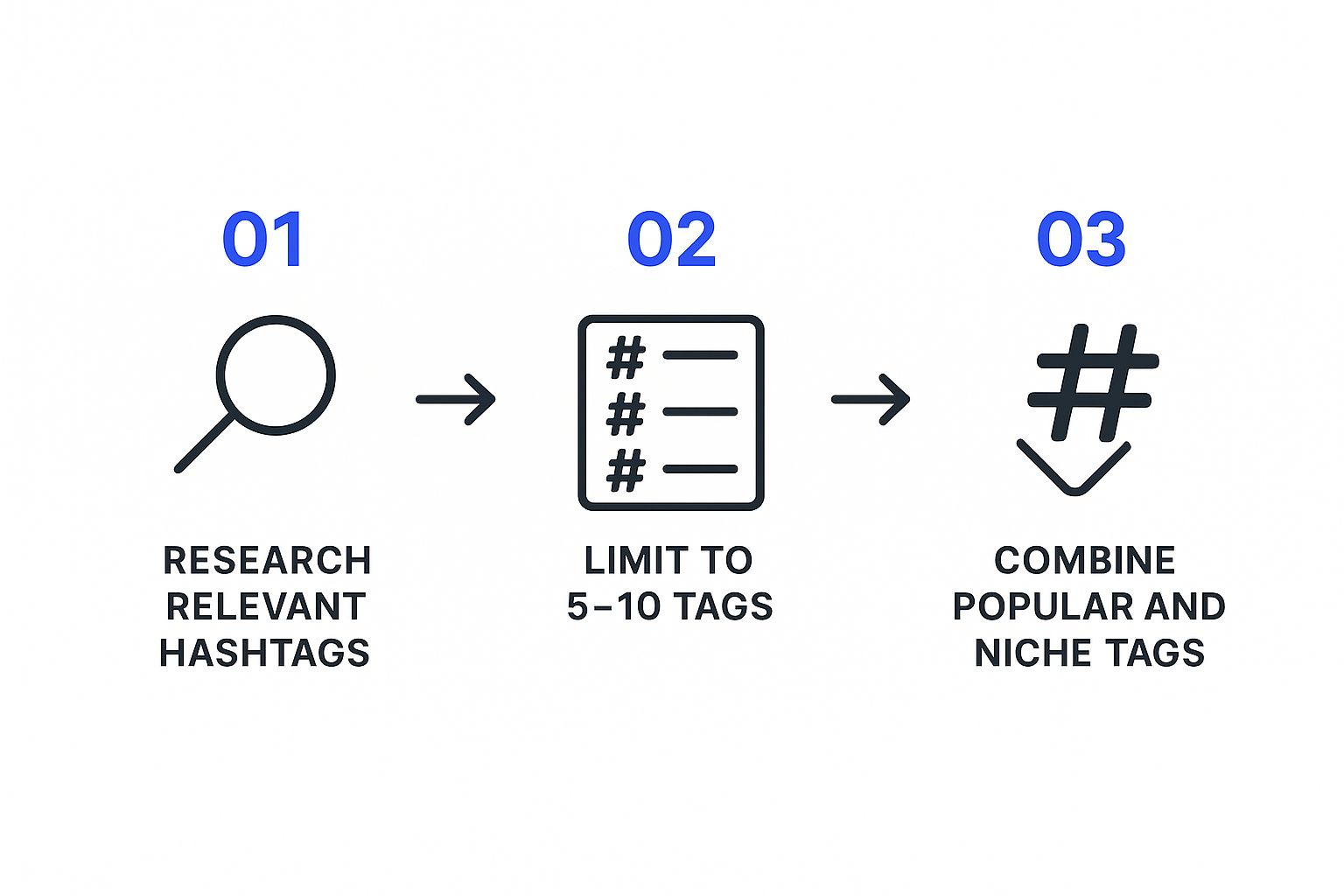
As the infographic lays out, this isn't random guesswork. It's a clear path from general research to a blended set of hashtags that form the core of a powerful strategy.
Think about it this way: your goal is to separate the valuable signals from all the noise. Is the person searching for
#BostonBakerya more qualified lead for your business than someone just scrolling through the 3 billion posts tagged#love? Absolutely.
This strategic balance is crucial, and it’s backed by data. It turns out that quality really does trump quantity. Research shows that posts with 8 to 12 well-chosen hashtags see 41% more engagement than posts that are stuffed with over 20. This just reinforces the need for a thoughtful, targeted approach instead of just spamming your captions.
To really get this down to a science, digging into an ultimate guide to hashtags can be incredibly helpful. It’s all about creating a repeatable framework that becomes a fundamental part of your larger social media content strategy and drives real, measurable growth.
Building Your Hashtag Management System
Let's be real: the best hashtag strategies aren't just one-and-done tasks. They're living, breathing systems that you constantly tweak and improve. If you truly want to master finding trending hashtags that deliver results, you need a way to organize your discoveries and track what’s actually working.
It’s time to move beyond random notes and messy lists. You need a structured approach.
A simple yet incredibly powerful method I’ve used for years is creating a "Hashtag Library." You can build this out in a basic spreadsheet or even a project management tool like Notion. The real magic happens when you stop lumping all your tags together and start organizing them by their specific job.
Creating Your Hashtag Library
I always recommend organizing your library into clear "pillars" that mirror your content strategy. This structure is a lifesaver, letting you quickly pull the right set of hashtags for any post without a second thought.
Here’s how I break it down:
- Core Brand Tags: Think of these as your signature. They're unique to your business, like
#PostSyncerTipsor a branded tagline. They’re fantastic for building brand identity and gathering user-generated content. - Product or Service Tags: These are the workhorses. They're descriptive tags that target users with high purchase intent. For us, that might look like
#AIContentStudioor#SocialMediaScheduling. - Community Tags: This is how you connect with your niche on a deeper level. A local coffee shop might use
#CoffeeLoversor#BaristaLife. These tags attract a passionate, genuinely engaged audience. - Campaign Tags: These are your short-term players, created for specific promotions or events. Think
#SummerSale2025. They make it incredibly easy to track participation and measure the buzz around a launch.
Keeping these lists organized is a solid first step, but how do you apply them at scale without losing your mind? Many of the top social media automation tools let you save entire hashtag groups. This feature is a game-changer, allowing you to add perfectly curated sets to your posts in just a couple of clicks.
Turning Data into Action
A library is just a collection of words until you know which ones are actually performing. This is where you close the loop by digging into your analytics. Don't just glance at likes and comments; you need to measure what drives discovery.
On Instagram, this is surprisingly easy. Just navigate to a specific post and tap "View Insights." Scroll down to the "Reach" section, and you’ll find the golden metric: Reach from Hashtags. That single number tells you exactly how many people found your post because of the tags you used.
By checking this metric regularly, you can quickly spot which of your curated sets are driving real growth and which ones are just taking up valuable space. This simple feedback loop is what transforms good effort into great results.
Common Questions About Trending Hashtags
As you start getting the hang of finding and using hashtags, a few questions always seem to surface. It's totally normal. Let's walk through some of the most common ones I hear, so you can move forward with confidence and sidestep those simple, yet costly, mistakes.
One of the big ones is, "Is it bad to use the same hashtags on every single post?" The short answer? Yes, it can be.
Think about it from the platform's perspective. When you copy and paste the exact same block of tags over and over, it can look a lot like spam, especially to sophisticated algorithms on platforms like Instagram. A much better approach is to build out a library of relevant tags and create smaller, curated sets that you can rotate depending on what you're actually posting about.
Another classic dilemma: hashtags in the caption or in the first comment? Truthfully, it makes no real difference to your reach or performance. The algorithm sees them either way. This one comes down to pure aesthetics. A lot of brands prefer tucking them into the first comment because it creates a cleaner, more focused caption. Your call.
How Often Should I Update My Hashtag Lists?
This is where strategy really comes into play. How often you refresh your hashtag lists depends entirely on the type of hashtag you're using. They aren't all created equal.
- Core Brand & Community Tags: These are your mainstays. They have a much longer shelf life. A quick review once a quarter is usually enough to make sure they're still hitting the mark.
- Trending & Campaign Tags: These move at the speed of social media. You should be looking for new ones for almost every post, or at the very least, checking in weekly.
What's hot today is often old news by next Tuesday. Staying agile is the name of the game.
Expert Tip: You absolutely cannot skip analyzing your performance. It's non-negotiable. Using the right social media reporting tools will show you which tags are actually driving impressions and which are just taking up space. This lets you make decisions based on real data, not just guesswork.
This cycle—research, apply, analyze, repeat—is what separates a basic hashtag strategy from one that genuinely fuels your brand's growth and engagement.
Ready to stop guessing and start strategizing? PostSyncer gives you the AI-powered tools and in-depth analytics you need to find high-performing hashtags, schedule your content, and measure your success all in one place. Start your free 7-day trial of PostSyncer today.
